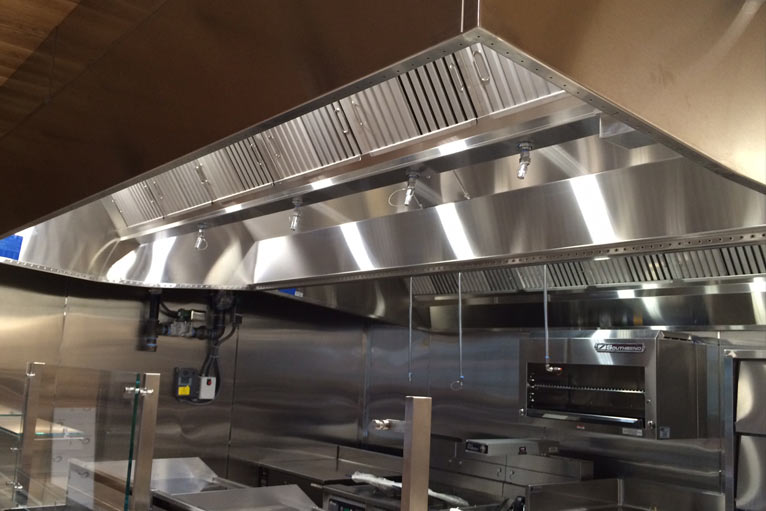Whenever the topic of commercial kitchen ventilation crops up, you know, like when you’re at a dinner party, or it’s the holidays, and Uncle Bob wants to chat, there are two terms that regularly interfere with a complete understanding. Cfm and static pressure, these terms go hand-in-hand (like Uncle Bob and Aunt Brenda) though we often don’t grasp the importance of each one.
Cubic feet per minute (CFM)
If either of these two terms is fairly well understood, it’s cfm. That stands for cubic feet per minute and is a measure of the volume airflow being transported. Think of a box in your hands that measures 12” x 12” x 12”. That box contains one cubic foot of air. If you sealed the box up and took it from your current location to another location, you just moved a cubic foot of air between these places. Instead of people sealing up boxes and moving them between spaces, though, we found a more efficient way to do this -with fans and electricity! Fans can move air much more efficiently, such that we describe the amount of air they move with the term “cubic feet per minute” … in other words, how many 12” x 12” x 12” boxes worth of air they can move every minute.
This cfm value is truly important to understand since we use it for much of the commercial kitchen ventilation design (among other things). We start by calculating the convective heat load of the cooking equipment (that’s the subject of another blog!) and then couple that with the style of hood, it’s efficiency, and its location to determine the cfm required to exhaust all that convective heat and effluent. In a simple kitchen analogy, we need to design with a fan capable of moving that calculated amount of air from the exhaust hood canopy, through the exhaust hood filters and up the duct that is connected to a fan, which brings it ultimately out of the space. Remember back to the “Hangs in the Balance” article, whatever we remove with this exhaust fan needs to be replaced with another fan to bring those same cfm back into the space and keep it “balanced”.
Static Pressure
Easy enough, right? It would be great if we could just check a box to order the fan with the correct cfm and move on with the design. Yet there is another parameter, here, that is significant and is less understood than cfm … static pressure. The simplest way to explain static pressure is “resistance to airflow”. In other words, how much force is needed to move the cfm? Think about blowing lightly through a straw, basically moving a few cfm through it. Now, try to quadruple the amount of air you are blowing through the straw. You’ll find that you need much more force to do so, blowing much harder to achieve this quadrupled airflow. This is the static pressure (resistance) and you can see how it is linked to the cfm. The units to express this is inches of water column (since the measurement classically included how much distance the static pressure displaces a column of water).
Super smart people did research on cfm and static pressure and found there are equations you can use to understand how these two parameters correlate. To sum it up and not bore you with the equations, the static pressure changes squared with the cfm. That means, if you don’t change anything in a system and double your cfm, you will quadruple your static pressure. This is sort of a big deal since a fan selected for a certain cfm and static pressure are often capable of moving more air (cfm), just not the elevated static pressures that increase non-linearly with the cfm.
Another reason that static pressure needs special consideration is that, as it increases, energy usage increases. This translates into higher energy costs. For a real world example, if you move 10,000 cfm with a fan at 0.5” w.c. you are using 1.6 hp (4.09A) and if you change that to 1” w.c. of static pressure, you are using 2.5 hp (6.39A). This is a difference of 850 kWh or 1329 kWh – a 55% increase in power. Your electric bill will forever illustrate this truth. So, you can see there’s pressure to understand static pressure and if you don’t understand it, it might just cost you dearly.
Published by:
Chris Lowell
Regional Sales Manager, Halton Company
Follow Chris Lowell on LinkedIn
Our recommended next article would be: What impact does a balanced building have on our lives?
Leave us a comment below, and we will answer, or if you have any questions, please send us a message here
Subscribe today to kitchenventilation.com
Stay up to date by subscribing to Halton’s Commercial Kitchen Ventilation Blogs by entering your email address to subscribe and Halton will provide you with the latest information on commercial kitchen exhaust hoods, pollution control units, air handling, and safety systems. You will receive notifications of new posts by email.


Comments
One response to “Cfm and static pressure … what does it all mean?”
[…] Cfm and static pressure … what does it all mean? – https://kitchenventilation.com/2020/04/16/cfm-and-static-pressure/ […]